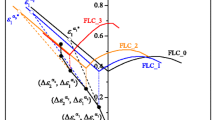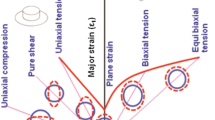Abstract
In this study, the effects of sheet thickness and anisotropy of AA2024-T4 on forming limit curve (FLC) are experimentally investigated according to ISO 12004-2 standard. A new limit strain measurement method is proposed by using the grid analysis method so as to determine limit strains conveniently and reliably. In addition to the regular test specimens, various widths are added to enhance the FLC’s accuracy at the plane strain condition (PSC). The accuracy and reliability of the proposed method are verified for different materials. Results illustrate that an increase in the sheet thickness increases the FLC level. The additional experiments for additional widths improve the accuracy of the FLC at the PSC, and the position of the lowest major strain value differs from the literature. However, the effect of anisotropy on the FLC is found to be insignificant. Finally, experimental and numerical case studies are carried out for conventional deep drawing, stretch drawing, and hydraulic bulge processes. Results reveal that different FLCs are necessary for different thicknesses for accurate predictions.
Similar content being viewed by others
References
Emilie H, Carsley JE, Verma R (2008) Development of forming limit diagrams of aluminum and magnesium sheet alloys at elevated temperatures. J Mater Eng Perform 17:288–296
Paraianu L, Comsa DS, Gracio JJ, Banabic D (2005) Modelling of the forming limit diagrams using the finite element method. The 8th International Conference of the European Scientific Association for Material Forming ESAFORM
Derogar A, Djavanroodi F (2011) Artificial neural network modeling of forming limit diagram. Mater Manuf Process 26:1415–1422
Narayanan RG, Naik BS (2010) Assessing the validity of original and modified failure criteria to predict the forming limit of unwelded and tailor welded blanks with longitudinal weld. Mater Manuf Process 25:1351–1358
Narayanasamy R, Narayanan SC (2007) Experimental analysis and evaluation of forming limit diagram for interstitial free steels. Mater Des 28:1490–1512
Giuliano G (2006) Analysis of forming limit diagram for superplastic materials. Int J Adv Manuf Technol 31(3–4):244–246
Hosford WF, Caddell R (2007) Metal forming: mechanics and metallurgy, 3rd edn. Cambridge University Press, New York
Graf A, Hosford WF (1990) Calculations of forming limit diagrams. Metall Trans A 21A:87–94
Raghavan KS (1995) A simple technique to generate in-plane forming limit curves and selected applications. Metall and Mater Trans A 26A:2075–2084
Ghosh AK, Hecker SS (1974) Stretching limits in sheet metals: in-plane versus out-of-plane deformation. Metall Trans 5:2161–2164
Ozturk F, Lee D (2005) Experimental and numerical analysis of out-of-plane formability test. J Mater Process Technol 170:247–253
Djavanroodi F, Derogar A (2010) Experimental and numerical evaluation of forming limit diagram for Ti6Al4V titanium and Al6061-T6 aluminum alloys sheets. Mater Des 31:4866–4875
Narayanasamy R, Narayanan SC (2008) Forming, fracture and wrinkling limit diagram for if steel sheets of different thickness. Mater Des 29:1467–1475
Kim J, Kang B-S, Lee (2009) Statistical evaluation of forming limit in hydroforming process using plastic instability combined with FORM. Int J Adv Manuf Technol 42:53–59
Standard test method for determining forming limit curves, ASTM-E-2218-02
ISO-12004-2 (2008) Metallic materials-sheet and strip-determination of forming-limit curves—part 2: determination of forming limit curves in the laboratory
Dilmec M, Halkaci HS, Ozturk F, Turkoz M (2012) Detailed investigation of forming limit determination standards for aluminum alloys. J Test Eval 41(1):1–12
Hashemi R, Ghazanfari A, Abrinia K, Assempour A (2012) Forming limit diagrams of ground St14 steel sheets with different thicknesses. SAE Int J Mater Manuf 5(1):60–64. doi:10.4271/2012-01-0018
Kleemola HJ, Kumpulainen JO (1980) Factors influencing the forming limit diagram: part II—influence of sheet thickness. J Mech Work Technol 3(3–4):303–311
Svensson C (2004) The influence of sheet thickness on the forming limit curves for austenitic stainless steel. Master Thesis, Örebro University, Sweden
Kumar DR (2002) Formability analysis of extra-deep drawing steel. J Mater Process Technol 130–131:31–41
Kim Y, Kim C, Lee S, Won S, Hwang S (2003) Forming limits for anisotropic sheet metals. JSME Int J Ser A 46(4):627–634
Yu Z, Lin Z, Zhao Y (2007) Evaluation of fracture limit in automotive aluminium alloy sheet forming. Mater Des 28:203–207
Boogaard T (2002) Thermally enhanced forming of aluminium sheet modeling and experiments. Universiteit Twente Ph.D. Thesis., The Netherlands
Keeler SP, Brazier WG (1977) Relationship Between laboratory material characterization and press shop formability. Microalloying 75 Proceedings 517-528. Union Carbide Corp., New York
Zadpoor AA, Sinke J, Benedictus R (2009) The effects of thickness on the formability of 2000 and 7000 series high strength aluminum alloys. Key Eng Mater 410–411:459–466
Tseng HC, Hung C, Huang CC (2010) An analysis of the formability of aluminum/copper clad metals with different thicknesses by the finite element method and experiment. Int J Adv Manuf Technol 49(9–12):1029–1036
Hosford WF, Duncan JL (1999) JOM 51:39
Jalinier JM, Schmitt JH (1982) Damage in sheet metal forming-II. Plastic instability. Acta Metall 30(9):1799–1809
Zadpoor AA, Sinke J, Benedictus R (2008) Comparative study of the formability prediction models for high-strength aluminum alloys. 9th International Conference on Technology of Plasticity (ICTP 2008), Gyengju, South Korea, 1258
Elwin LR (1990) ASM handbook volume 2, properties and selection: nonferrous alloys and special-purpose materials, introduction to aluminum and aluminum alloys. ASM International, America
Takuda H, Hatta N (1998) Numerical analysis of the formability of an aluminum 2024 alloy sheet and its laminates with steel sheets. Metall Mater Trans A 29A:2829–2834
Hursman TL (1978) Development of forming limit curves for aerospace aluminum alloys. Formability topics-metallic materials. ASTM STP 647. In: Niemeler BA, Schmieder AK and Newby JR (eds) American Society for Testing and Materials, 122–149
Ozturk F, Dilmec M, Turkoz M, Ece RE, Halkaci HS (2009) Grid marking and measurement methods for sheet metal formability. 5th International Conference and Exhibition on Design and Production of Machines and Dies/Molds, Aydın, Turkey, 41-49
Merklein M, Kuppert A, Geiger M (2010) Time dependent determination of forming limit diagrams. CIRP Ann Manuf Technol 59(1):295–298
Vallellano C, Morales D, Garcia-Lomas FJ (2008) A study to predict failure in biaxially stretched sheets of aluminum alloy 2024-T3. Mater Manuf Process 23:303–310
Author information
Authors and Affiliations
Corresponding author
Rights and permissions
About this article
Cite this article
Dilmec, M., Halkaci, H.S., Ozturk, F. et al. Effects of sheet thickness and anisotropy on forming limit curves of AA2024-T4. Int J Adv Manuf Technol 67, 2689–2700 (2013). https://doi.org/10.1007/s00170-012-4684-0
Received:
Accepted:
Published:
Issue Date:
DOI: https://doi.org/10.1007/s00170-012-4684-0




